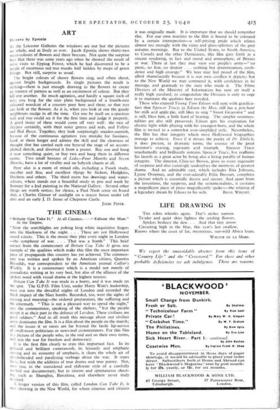ART Flowers by Epstein AT the Leicester Galleries the windows
are out but the pictures are whole, and as lively as ever. Jacob Epstein shows thirty-two water-colours of flowers and three -bronzes. Not quite the surprise here that there was some years ago when he showed the result of some visits to Epping Forest, which he had discovered to be a jungle of enormous red tree trunks half hidden by mops of green foliage. But still, surprise as usual.
The bright colours of showy flowers sing, and often shout, against bright backgrounds. In single pictures the result is striking—there is just enough drawing in the flowers to create an interest of pattern as well as an excitement of colour. But they kill one another. So much agitation, and hardly a square inch of rest; you long for the nice plain background of a fourth-rate coloured woodcut of a country posy here and there, so that you can look at the flowers. As it is, when you look at one the gaudy neighbours nudge in all the time. Get one by itself on a spacious wall and you could see it for the first time and judge it properly. A good many of these would come off very well: the two of Poppies certainly, with their noisy greens and reds, and Yellow and Red Roses. Together; they look surprisingly anaiden-auntish, because of the continuous agitation you mistake for fussiness. Look at them longer and admire the skill and the clearness of thought that has carried each one beyond the stage of an accom- plished sketch, and diverted it from a poster. Buy one and hang it near something quiet, or buy two and hang them in different rooms. Two small bronzes of Leda—Four Months and Seven Months, have a lot of vitality and no babyish charm at all.
Here also is a room of mixed oils, including a Fuseli study, macabre and fine, and excellent things by Sickert, Hodgkins, Hitchens and others. The third room has drawings and water- colours, where where stands out a beautiful study in pen and wash by Romney for a bad painting in the National Gallery. Several other things are worth notice; for choice, a Paul Nash scene On board ship, a Charles Ginner of sunlight on a stucco house under tall elms and an early J. D. limes of Chepstow Castle.
JOHN PIPER.


























 Previous page
Previous page